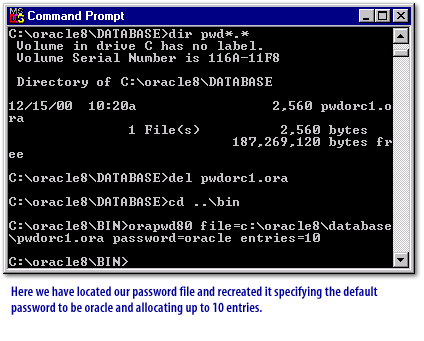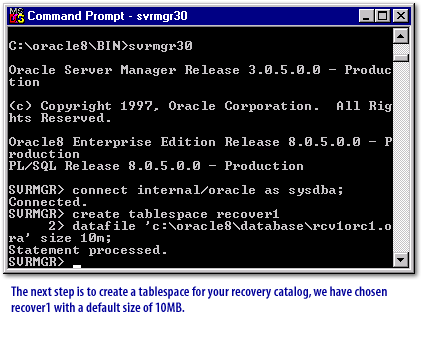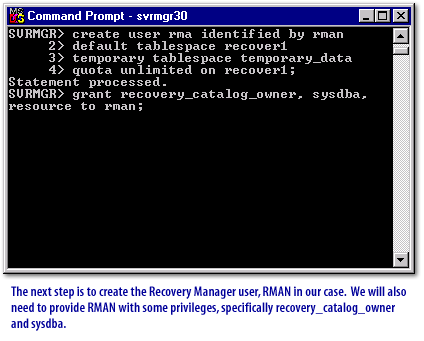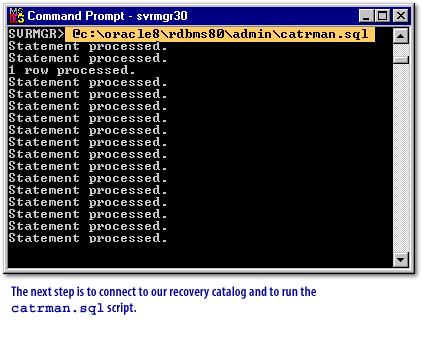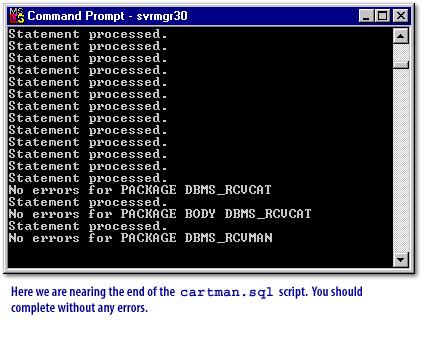Recovery Catalog Creation
Creating the Recovery Catalog
Although it is advisable to create the recovery catalog in the same version as the target database, this is not required in the case of a single recovery catalog serving a mix of 9i, 10g and 11g databases.
In this case, the recovery catalog must be created in a database that is running the same version as the highest version of the target databases.
However, a catalog in a 9i or 10g database cannot be used to backup an Oracle 11g target since Oracle 9i and 10g were predecessors to Oracle 11g.
Since the recovery catalog is capable of holding backup-related metadata longer than the target databases control file, this essentially depicts that the storage should be persistent compared to the control file.
Since the recovery catalog is capable of holding backup-related metadata longer than the target databases control file, this essentially depicts that the storage should be persistent compared to the control file.
Persistent Storage
In Oracle, the persistent storage lies only in the form of datafiles managed by means of tablespaces .
The same holds true for the recovery catalog, which is going to be managed within a dedicated tablespace specifically created for the recovery catalog.
Recovery catalog creation demands the creation of its owner which will be used to manage it.
Although Oracle does not prevent creating the recovery catalog schema in the target database, such an implementation is unacceptable. It is recommended that you create this schema on a different database that resides at a remote host. If you create this schema on the same database and you lose the database, you also lose all backup metadata as well. If you create this schema using a different database at the same host, due to media failure, you can lose 1) all hard drives and 2) backup metadata. For this reason, it is imperative that you create the schema on a different database that resides at remote host (separate physical server).
Therefore, it is recommended that the recovery catalog schema be put in a different database that resides on a different server.
In order to create the recovery catalog, you need to create a user, that is, a separate schema to hold the metadata of backups, and then create a catalog which holds RMAN backup metadata of registered databases.
Listed below are the main steps in creating the recovery catalog:
Although Oracle does not prevent creating the recovery catalog schema in the target database, such an implementation is unacceptable. It is recommended that you create this schema on a different database that resides at a remote host. If you create this schema on the same database and you lose the database, you also lose all backup metadata as well. If you create this schema using a different database at the same host, due to media failure, you can lose 1) all hard drives and 2) backup metadata. For this reason, it is imperative that you create the schema on a different database that resides at remote host (separate physical server).
Therefore, it is recommended that the recovery catalog schema be put in a different database that resides on a different server.
In order to create the recovery catalog, you need to create a user, that is, a separate schema to hold the metadata of backups, and then create a catalog which holds RMAN backup metadata of registered databases.
Listed below are the main steps in creating the recovery catalog:
- Create a tablespace that holds backup metadata
- Create a user that owns the catalog
- Grant recovery_catalog_owner privilege to that user
- Using RMAN executable, connect to the catalog database
- Use create catalog command to create a recovery catalog
